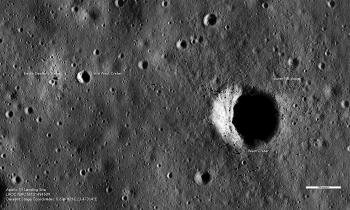A new video, created at Arizona State University's School of Earth and Space Exploration, shows what Armstrong saw out his window as the lander descended — and that means we can see for yourself why he took control. They used the crew's voice recording, the timings, a video taken on film and images taken from lunar orbit by the LROC over the last 10 years.
The only actual visual record of the actual Apollo 11 landing is from a 16 mm time-lapse movie camera, running at six frames a second and mounted in Edwin "Buzz" Aldrin’s window. Aldrin was designated as the LM pilot, but for the actual landing he stood on the right side of the cabin and his role was to announce the LM's altitude and rates of descent and forward motion. Armstrong's place was on the cabin's left side. Due to the small size of the lander windows and the angle at which the movie camera was mounted, what mission commander Neil Armstrong saw as he flew the LM to the landing was not recorded.
The Arizona State University team reconstructed the last three minutes of the landing trajectory (latitude, longitude, orientation, velocity and altitude) using lunar landmark navigation and altitude callouts from the crew's voice recording.
As the video begins, Armstrong could see the auto-targeting was aiming to land on the rocky flank of West Crater (625 feet wide). This caused him to take over manual control and fly horizontally, searching for a safe landing spot. At the time, only Armstrong saw the hazard, and he was too busy flying the LM to discuss the situation with mission control.
After flying over the hazards presented by the bouldery flank of West Crater, Armstrong spotted a safe landing site about 1,600 feet ahead where he carefully descended to the surface. Just before landing, the LM flew over what was later called Little West Crater (135 feet wide). After landing, Armstrong visited and photographed this crater during his extravehicular activity.

The approach to the site of the first manned lunar landing, Tranquility Base, gave the Apollo 11 astronauts anxious moments during the descent. The autopilot was going to set the Eagle lunar lander down amid the boulders on the flanks of West Crater, the largest crater in the image. Commander Neil Armstrong took over and flew the Eagle manually to a safer spot, seen here on the left side of the image. The lander's descent stage remains where it touched down. This image was taken by the Lunar Reconnaissance Orbit Camera in June 2010, almost 41 years after the landing. Photo by NASA/GSFC/Arizona State University
"Of course, during the landing he was able to lean forward and back and turn his head to gain a view that was better than the simple, fixed viewpoint presented here," said Mark Robinson, principal investigator for the Lunar Reconnaissance Orbiter Camera (LROC) and professor in the school. "However, our simulated movie lets you relive those dramatic moments."
Robinson points out that because LROC's images were taken almost 50 years after the actual landing, the video shows the lander's descent stage on the surface. (It was used as a launch pad when the astronauts blasted off for their return to Earth.) And the video shows where they disturbed the lunar soil as they walked: look for dark thread-like paths.
"Obviously," said Robinson, "these weren't visible to Armstrong during the landing approach!"




Comments